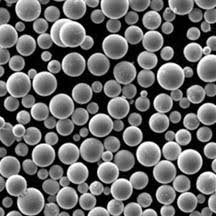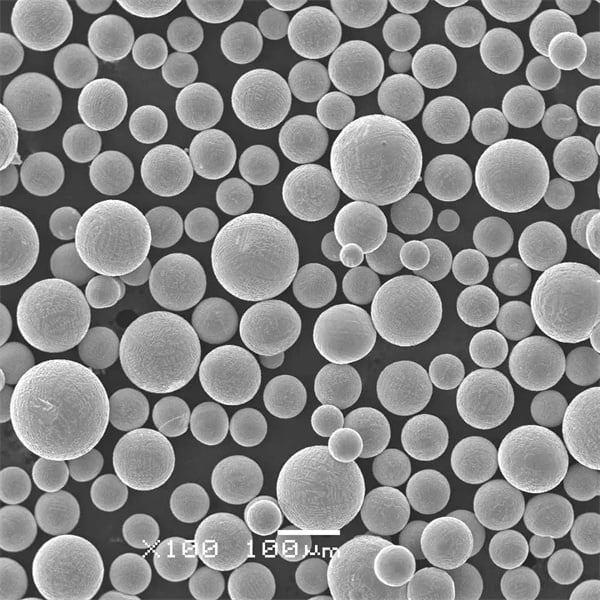Méně satelitních částic Prášek
Obsah
Představte si stavění složitých předmětů vrstvu po vrstvě, přičemž každá vrstva obsahuje přesné nanesení kovového prášku. To je kouzlo aditivní výroby (AM), známé také jako 3D tisk. Ale co když se tyto drobné kovové částice místo toho, aby vytvořily hladký povrch, shlukly dohromady a vytvořily nedokonalosti? Zde přichází na řadu koncept „satelitních částic“ a dosažení prášku méně satelitních částic se stává rozhodující pro bezchybný povrch.
Co jsou to satelitní částice?
Představte si dokonalou kovovou kouli, ideální pro AM. Nyní si představte menší, nepravidelně tvarované částice ulpívající na jeho povrchu. Jsou to satelitní částice, působící jako nevítaní stopaři na cestě za hladkým, vysoce kvalitním finálním produktem. Jejich přítomnost může vést k několika problémům:
- Drsnost povrchu: Satelitní částice narušují rovnoměrné ukládání prášku, což má za následek drsnou a nerovnoměrnou povrchovou úpravu tištěného předmětu.
- Slabé spojení mezi vrstvami: Když se tyto satelitní částice dostanou mezi hlavní vrstvy prášku, mohou bránit správné fúzi mezi nimi, což vede ke slabému spojení mezi vrstvami a potenciálně ke snížení pevnosti objektu.
- Pórovitost: Satelitní částice mohou zachycovat vzduchové kapsy uvnitř tištěného předmětu a vytvářet nežádoucí poréznost, která ovlivňuje jeho mechanické vlastnosti a estetiku.

The Quest for Flawless Metal Powders
V AM se používá několik typů kovových prášků, z nichž každý má své vlastní charakteristiky a náchylnost k satelitním částicím. Zde je bližší pohled na deset oblíbených možností:
| Model kovového prášku | Popis |
|---|---|
| Plynem atomizovaná nerezová ocel 316L (SS316L): Všestranný a široce používaný prášek nabízející vynikající odolnost proti korozi. | Středně náchylný |
| Titan (Ti-6Al-4V) roztavený elektronovým paprskem (EBM): Vysoce pevná titanová slitina známá pro svou biokompatibilitu. | Méně náchylné |
| Superalloy Inconel 625 na bázi niklu: Proslulý svou pevností při vysokých teplotách. | Středně náchylný |
| Hliníková slitina AlSi10Mg: Oblíbená volba pro lehké aplikace s dobrou svařitelností. | Vysoce náchylný |
| Měď (Cu): Nabízí vynikající tepelnou a elektrickou vodivost. | Středně náchylný |
| Kobalt-chrom (CoCr): Biokompatibilní materiál používaný pro lékařské implantáty. | Méně náchylné |
| Nástrojová ocel (H13): Ocel odolná proti opotřebení pro nástrojové aplikace. | Středně náchylný |
| Inconel 718: Vysoce pevná, vysokoteplotní slitina nikl-chrom. | Středně náchylný |
| Maraging Steel: Vysokopevnostní ocel s vynikající houževnatostí. | Středně náchylný |
| Wolfram (W): Nabízí výjimečné vlastnosti při vysokých teplotách. | Vysoce náchylný |
Jak vidíte, náchylnost k satelitním částicím se liší v závislosti na kovu a výrobním procesu. Plynem atomizované prášky, díky jejich rychlému tuhnutí, mají tendenci být náchylnější k tvorbě satelitních částic ve srovnání s EBM prášky. Svou roli hraje také velikost a distribuce částic, u jemnějších prášků je vyšší pravděpodobnost shlukování.
Výhody Méně satelitních částic Prášek
Zde je důvod, proč je dosažení prášku s menším počtem satelitních částic zásadní pro úspěšnou AM:
- Vynikající povrchová úprava: Snížená drsnost povrchu se promítá do vizuálně přitažlivého a vysoce kvalitního finálního produktu.
- Vylepšené mechanické vlastnosti: Silnější spojení mezi vrstvami vede k robustnějšímu předmětu se zlepšenou mechanickou pevností a odolností proti únavě.
- Snížené dodatečné zpracování: Minimalizované nedokonalosti povrchu vyžadují méně kroků následného zpracování, jako je broušení nebo leštění, což šetří čas a zdroje.
- Vylepšená svoboda designu: Bezchybné povrchové úpravy umožňují vytvářet složité geometrie s jemnějšími detaily.
Výzvy a řešení:
Výroba kovových prášků s minimem satelitních částic vyžaduje jemnou rovnováhu. Zde jsou některé strategie používané výrobci:
- Optimalizace procesů: Jemné doladění parametrů, jako je tlak atomizačního plynu a průtoková rychlost, může minimalizovat tvorbu satelitních částic během procesu výroby prášku.
- Sférizace: Techniky následného zpracování, jako je atomizace plazmatu, lze použít k přeměně nepravidelných částic na téměř dokonalé koule, čímž se sníží pravděpodobnost shlukování.
- Prosévání prášku: Prosévání prášku odstraňuje větší částice a aglomeráty, což podporuje konzistentnější distribuci velikosti částic.
Budoucnost prášku s menším počtem satelitních částic
Jak se AM neustále vyvíjí, poptávka po vysoce kvalitních kovových prášcích s minimem satelitních částic bude jen stoupat. Pokračuje výzkum ve vývoji nových výrobních technik a metod následného zpracování k dosažení ještě vyšší úrovně dokonalosti prášku. Představte si budoucnost, kde AM bude vyrábět objekty s téměř zrcadlovou povrchovou úpravou a nesrovnatelnou pevností, to vše díky neúnavné snaze o menší počet satelitních částic.
Aplikace z Méně satelitních částic Prášek
Výhody menšího počtu prášků satelitních částic se rozšiřují do různých AM aplikací, které vyžadují jak estetiku, tak funkčnost:
- Letectví: Bezchybné povrchové úpravy jsou zásadní pro součásti v letadlech a kosmických lodích, kde i drobné nedokonalosti povrchu mohou ovlivnit aerodynamiku a výkon. Méně satelitních částic zajišťuje hladké proudění vzduchu, snižuje odpor vzduchu a zlepšuje spotřebu paliva.
- Lékařské implantáty: Ve světě lékařských implantátů vládne biokompatibilita a síla. Prášky s minimem satelitních částic vytvářejí implantáty s hladkým povrchem, snižují riziko infekce a podporují lepší integraci tkání. Silná mezivrstvová vazba navíc zajišťuje, že implantát vydrží namáhání a namáhání každodenního života.
- Spotřební zboží: Od šperků na míru až po špičkovou spotřební elektroniku, AM dělá svou značku na každodenních produktech. Prášky s minimem satelitních částic umožňují vytváření esteticky příjemných předmětů se složitými detaily a luxusním dojmem. Představte si pouzdro na telefon s bezchybným kovovým povrchem nebo pár na míru vyrobených slunečních brýlí s hladkým reflexním povrchem – to vše díky vynikající kvalitě prášku.
- Automobilový průmysl: Automobilový průmysl stále více přijímá AM pro lehké komponenty a složité konstrukce. Méně prášků satelitních částic zajišťuje hladký povrch dílů, jako jsou písty a součásti motoru, čímž se snižuje tření a opotřebení. Kromě toho mohou vylepšené mechanické vlastnosti vést k lehčím, ale pevnějším součástem, což přispívá k lepší spotřebě paliva.
Úvahy a kompromisy:
I když je honba za menším počtem satelitních částic chvályhodná, je důležité si uvědomit některé potenciální kompromisy:
- Náklady: Výroba prášků s minimem satelitních částic může být složitý proces náročný na zdroje, což může vést k vyšším nákladům na prášek.
- Dostupnost: Ne všechny kovové prášky jsou snadno dostupné s minimem satelitních částic. V závislosti na konkrétním materiálu a požadované velikosti částic může existovat omezení dostupnosti.
Nalezení správné rovnováhy:
Rozhodnutí, zda upřednostnit minimální družicové částice, závisí na konkrétní aplikaci. U kritických součástí v letectví nebo lékařských implantátech, kde jsou prvořadé bezchybné povrchové úpravy a výjimečná pevnost, mohou být dodatečné náklady a potenciální omezení dostupnosti ospravedlnitelné. U méně náročných aplikací, jako je určité spotřební zboží, však může být dosaženo rovnováhy mezi cenou a úrovní dosažitelné povrchové úpravy.
Výhody a omezení prášku s menším počtem satelitních částic
| Vlastnosti | Výhody | Omezení |
|---|---|---|
| Povrchová úprava | Vynikající, hladké, vizuálně přitažlivé | Může zvýšit cenu prášku |
| Mechanické vlastnosti | Silnější spojení mezi vrstvami, zlepšená pevnost, odolnost proti únavě | Ne vždy jsou snadno dostupné pro všechny materiály |
| Následné zpracování | Snížená potřeba broušení/leštění, šetří čas a zdroje | Může vyžadovat specializované výrobní techniky |
| Svoboda designu | Umožňuje složité geometrie a jemnější detaily | Nemusí být nákladově efektivní pro všechny aplikace |
Specifikace prášku s menším počtem satelitních částic:
Při spolupráci s poskytovateli AM služeb je důležité jasně specifikovat vaše požadavky týkající se satelitních částic. Zde je několik klíčových bodů, které je třeba zvážit:
- Použití: Sdělte zamýšlené použití tištěného předmětu. To pomáhá poskytovateli služeb doporučit vhodný typ prášku s požadovanou úrovní minimálních satelitních částic.
- Očekávání povrchové úpravy: Jasně definujte požadované požadavky na povrchovou úpravu. Usilujete o bezchybný, zrcadlový povrch, nebo je přijatelný středně hladký povrch?
- Rozpočtová omezení: Diskutujte o svých rozpočtových omezeních. Poskytovatel služeb pak může navrhnout práškové varianty, které vyvažují minimální množství satelitních částic s nákladovou efektivitou.

Nejčastější dotazy
Otázka: Jak mohu zjistit, zda kovový prášek obsahuje mnoho satelitních částic?
Odpověď: Vizuální kontrola pod mikroskopem může odhalit přítomnost satelitních částic. Renomovaní poskytovatelé AM služeb obvykle poskytují podrobné informace o charakteristikách prášku, včetně úrovně satelitních částic.
Otázka: Existují nějaké alternativní metody k dosažení hladkého povrchu s prášky obsahujícími satelitní částice?
Odpověď: Ano, ke zlepšení povrchové úpravy tištěného předmětu lze použít techniky následného zpracování, jako je broušení, leštění nebo chemické leptání. Ty však zvyšují celkovou dobu zpracování a náklady.
Otázka: Jaké jsou environmentální důsledky výroby prášků s minimem satelitních částic?
Odpověď: Některé techniky výroby prášku mohou být energeticky náročné. Pokračující výzkum se však zaměřuje na vývoj udržitelnějších a ekologičtějších metod výroby vysoce kvalitních kovových prášků.
Sdílet na
MET3DP Technology Co., LTD je předním poskytovatelem řešení aditivní výroby se sídlem v Qingdao v Číně. Naše společnost se specializuje na zařízení pro 3D tisk a vysoce výkonné kovové prášky pro průmyslové aplikace.
Dotaz k získání nejlepší ceny a přizpůsobeného řešení pro vaše podnikání!
Související články

Vysoce výkonné segmenty lopatek trysek: Revoluce v účinnosti turbín díky 3D tisku z kovu
Přečtěte si více "O Met3DP
Nedávná aktualizace
Náš produkt
KONTAKTUJTE NÁS
Nějaké otázky? Pošlete nám zprávu hned teď! Po obdržení vaší zprávy obsloužíme vaši žádost s celým týmem.

Kovové prášky pro 3D tisk a aditivní výrobu
SPOLEČNOST
PRODUKT
kontaktní informace
- Město Qingdao, Shandong, Čína
- [email protected]
- [email protected]
- +86 19116340731

















